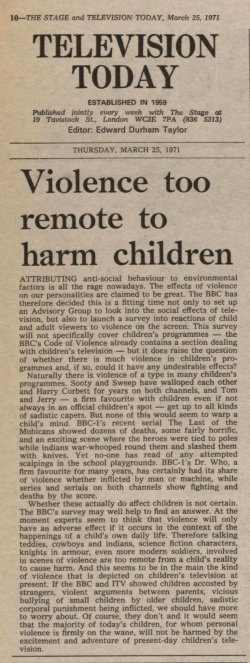Violence too remote to harm children
- Publication: The Stage and Television Today
- Date: 1971-03-25
- Author:
- Page: 10
- Language: English
ATTRIBUTING anti-social behaviour to environmental factors is all the rage nowadays. The effects of violence on our personalities are claimed to be great. The BBC has therefore decided this is a fitting time not only to set up an Advisory Group to look into the social effects of television, but also to launch a survey into reactions of child and adult viewers to violence on the screen. This survey will not specifically cover children's programmes — the BBC's Code of Violence already contains a section dealing with children's television — but it does raise the question of whether there is much violence in children's programmes and, if so, could it have any undesirable effects?
Naturally there is violence of a type in many children's programmes. Sooty and Sweep have walloped each other and Harry Corbett for years on both channels, and Tom and Jerry — a firm favourite with children even if not always in an official children's spot — get up to all kinds of sadistic capers. But none of this would seem to warp a child's mind. BBC-l's recent serial The Last of the Mohicans showed dozens of deaths, some fairly horrific, and an exciting scene where the heroes were tied to poles while indians war-whooped round them and slashed them with knives. Yet no-one has read of any attempted scalpings in the school playgrounds. BBC-1's Dr. Who, a firm favourite for many years, has certainly had its share of violence whether inflicted by man or machine, while series and serials on both channels show fighting and deaths by the score.
Whether these actually do affect children is not certain. The BBC's survey may well help to find an answer. At the moment experts seem to think that violence will only have an adverse effect if it occurs in the context of the happenings of a child's own daily life. Therefore talking teddies, cowboys and indians, science fiction characters, knights in armour, even more modern soldiers, involved in scenes of violence are too remote from a child's reality to cause harm. And this seems to be in the main the kind of violence that is depicted on children's television at present. If the BBC and ITV showed children accosted by strangers, violent arguments between parents, vicious bullying of small children by older children, sadistic corporal punishment being inflicted, we should have more to worry about. Of course, they don't and it would seem that the majority of today's children, for whom personal violence is firmly on the wane, will not be harmed by the excitement and adventure of present-day children's television.
Disclaimer: These citations are created on-the-fly using primitive parsing techniques. You should double-check all citations. Send feedback to whovian@cuttingsarchive.org
- APA 6th ed.: (1971-03-25). Violence too remote to harm children. The Stage and Television Today p. 10.
- MLA 7th ed.: "Violence too remote to harm children." The Stage and Television Today [add city] 1971-03-25, 10. Print.
- Chicago 15th ed.: "Violence too remote to harm children." The Stage and Television Today, edition, sec., 1971-03-25
- Turabian: "Violence too remote to harm children." The Stage and Television Today, 1971-03-25, section, 10 edition.
- Wikipedia (this article): <ref>{{cite news| title=Violence too remote to harm children | url=http://cuttingsarchive.org/index.php/Violence_too_remote_to_harm_children | work=The Stage and Television Today | pages=10 | date=1971-03-25 | via=Doctor Who Cuttings Archive | accessdate=21 May 2025 }}</ref>
- Wikipedia (this page): <ref>{{cite web | title=Violence too remote to harm children | url=http://cuttingsarchive.org/index.php/Violence_too_remote_to_harm_children | work=Doctor Who Cuttings Archive | accessdate=21 May 2025}}</ref>
